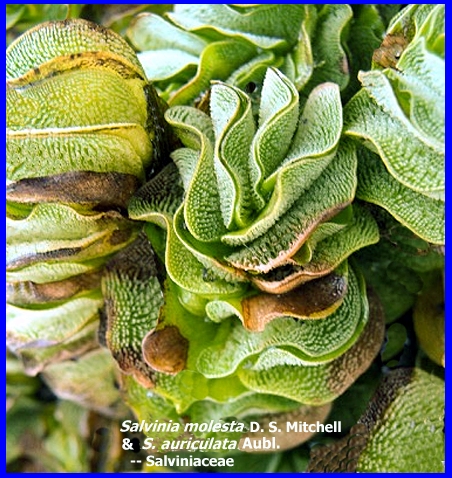FILE: <ch-98.htm> GENERAL INDEX [Navigate to MAIN MENU
]
|
SALVINIA Salvinia molesta D. S. Mitchell
& S.
auriculata Aubl. -- Salviniaceae (Contacts) ----- CLICK on Photo to enlarge & search for Subject Matter with Ctrl/F. GO TO ALL: Bio-Control Cases Salvinia molesta is a free floating aquatic
fern native to Brazil, which was spread as an aquarium plant and botanical
curiosity to tropical and subtropical parts of Africa, Asia, Australia, Fiji
and New Guinea. It has propagated
vegetatively and now ranks as one of the world's most important aquatic
noxious plants (Thomas & Room 1986, Goeden & Andrés 1999). Salvinia spread to
Lake Kariba on the Zambia/Zimbabwe border in 1955 and quickly spread to cover
1,000 km2 or 21% of the lake's surface. Commonwealth entomologists conducted foreign exploration in
South American for Salvinia auricularia Aublet, often
called Kariba weed. Three insect
species, the moth Samea multiplicatus Guenee
(Lepidoptera: Pyralidae), the grasshopper, Paulinia acuminata
(DeGeer) (Orthoptera: Acrididae), and the weevil Cyrtobagous singularis
Hustache (Coleoptera: Curculionidae), were considered the best candidates for
biological control. During 1960-1970
all three species of insects were released on Lake Kariba and elsewhere in
Africa and Fiji. Only P. acuminata became established on Lake Kariba and provided
limited control of the fern. Goeden & Andrés
(1999) relate how by 1970 Kariba weed was cited as one of the best documented
contemporary examples of the importance of taxonomy to biological control of
plants. However a pressed specimen of
Kariba weed collected in 1941 and preserved in the Rio de Janeiro Botanic
Garden was not Salvinia auricularia but rather a new
species described as S. molesta in 1972. By 1978 the weed was determined to be a
sterile hybrid that originated in southeastern Brazil. Exploration by Commonwealth entomologists
resulted in the detection, study and recommendation of Samea multiplicatus,
P. acuminata, and what then was thought to be a separate
biotype of C. singularis, as the most
promising candidate biological control agents. Introductions of the weevil were made to Australia in 1980
where it established readily and in less than two years destroyed a 200 ha
infestation on Lake Moondarra in northern Australia. Further studies resulted in the weevil's
description as Cyrtobagous salviniae Calder &
Sands. Results of this project
support the concept that the best natural enemies are obtained from the
target plant species (Goeden & Kok 1986, Moran et al. 1986), a concept
that is frequently challenged (Hokkanen & Pimentel 1984). Crytobagous salviniae was
transferred to Papua, New Guinea from Australia in 1982 and established only
after the novel manipulation of the weevil's environment in field release
cages (Goeden & Andrés 1999). This
involved regular applications of urea to the caged weed which increased its
nitrogen content and enhanced its nutritional suitability for the weevils
which then increased their reproduction rate. The weevils continued to multiply in great numbers once the
cages were opened and the weevils were allowed access to large volumes of
unfertilized weeds that covered Sepik Lake to a depth of ca. 1 m. Following a
large scale redistribution effort in August 1985, salvinia has been reduced
from 25 km2 of water surface on the lower floodplain of the Sepik
River to only 2 km2, representing the destruction of two million
metric tons of salvinia in two years (Goeden & Andrés 1999). Salvinia auriculata Aubl. in
Africa has been targeted for biological control using a grasshopper, Paulinia acuminata DeGeer, a weevil, Cyrtobagous singularis
Hulst., and a moth, Samea multiplicallis Guenée (Bennett
1966). REFERENCES: [Additional references may be found at: MELVYL
Library ] Bennett, F. D. 1966. Investigations on the insects attacking
aquatic ferns, Salvinia spp.
in Trinidad and northern South America.
Proc. S. Weed Conf. 19:
497-504. Goeden, R. D. & L. A. Andrés. 1999. Biological control
of weeds in terrestrial and aquatic environments. IN: Bellows, T. S.
& T. W. Fisher (eds.), Handbook of
Biological Control: Principles and
Applications. Academic Press, San
Diego, New York. 1046 p. Goeden, R. D. & L. T. Kok. 1986. Comments on a
proposed "new" approach for selecting agents for the biological
control of weeds. Canad. Ent.
118: 51-58. Hokkanen, H. & D. Pimentel.
1984. New approach for
selecting biological control agents. Canad. Ent.
116: 1109-21. Moran, V. C., S. Neser & J. H.
Hoffmann. 1986.
The potential of insect herbivores for the biological control of
invasive plants in South Africa, p. 261-68.
In: I. A. W. MacDonald, F. J. Kruger & A.
A. Ferrar (eds.), The Ecology and Management of Biological Invasions in
Southern Africa. Oxford Univ. Press,
Capetown. South Africa. Thomas, P. A. & P. M. Room.
1986. Taxonomy and control of Salvinia molesta. Nature
320: 581-84. |
